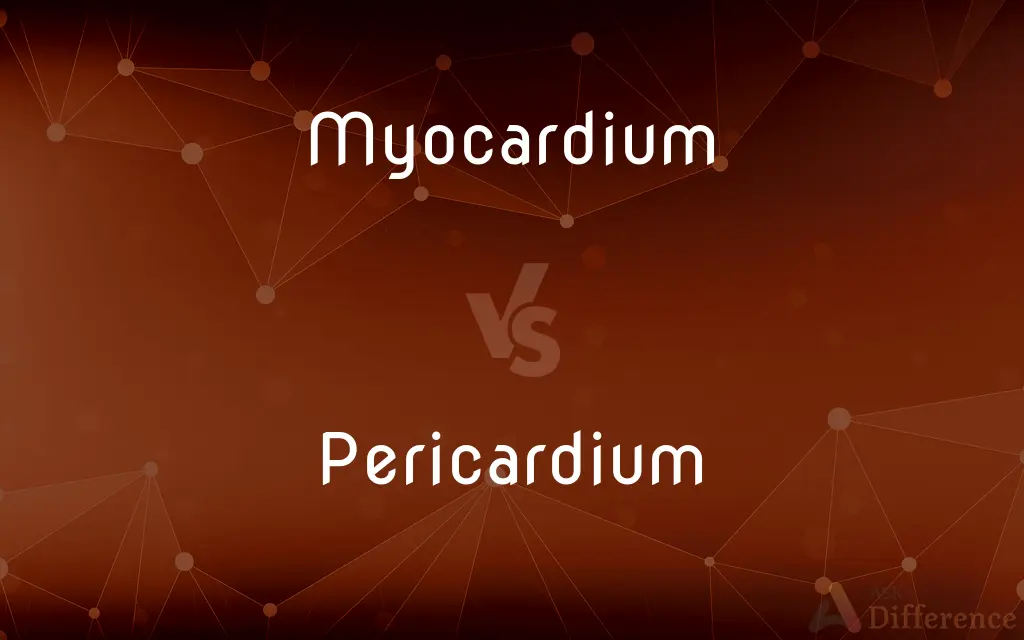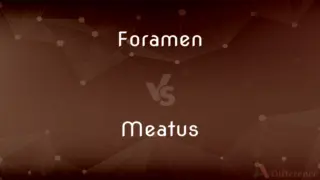Myocardium vs. Pericardium — What's the Difference?
Edited by Tayyaba Rehman — By Fiza Rafique — Updated on April 16, 2024
The myocardium is the muscular layer of the heart wall that contracts to pump blood, while the pericardium is a protective sac surrounding the heart.

Difference Between Myocardium and Pericardium
Table of Contents
ADVERTISEMENT
Key Differences
The myocardium constitutes the thick, muscular middle layer of the heart's wall, primarily responsible for the heart's pumping action through its contraction. On the other hand, the pericardium is a double-layered membrane that encloses the heart, providing lubrication and protection against infection and physical trauma.
The myocardium is composed of specialized cardiac muscle cells that are designed for endurance and continuous contraction. In contrast, the pericardium consists of two layers: a fibrous outer layer that prevents overexpansion of the heart and a serous inner layer that produces fluid to reduce friction during heartbeats.
In terms of function, the myocardium is crucial for creating the force needed to circulate blood throughout the body, whereas the pericardium's main role is to stabilize the heart within the chest and shield it from external shocks and infections.
Diseases affecting the myocardium, such as myocarditis or cardiomyopathy, directly impair the heart’s ability to pump blood. Conversely, conditions affecting the pericardium, like pericarditis or pericardial effusion, typically influence the heart's environment, potentially compressing it and affecting its function indirectly.
While the myocardium requires a constant supply of oxygen and nutrients delivered via coronary arteries to sustain its intense activity, the pericardium does not have such high metabolic demands but still plays a critical role in overall cardiac health by maintaining optimal pressure and positioning of the heart.
ADVERTISEMENT
Comparison Chart
Definition
Muscular middle layer of the heart's wall.
Protective double-layered sac around the heart.
Function
Pumps blood by contracting.
Protects and lubricates the heart.
Composition
Cardiac muscle cells.
Fibrous and serous layers.
Diseases
Myocarditis, cardiomyopathy.
Pericarditis, pericardial effusion.
Role in Heart Health
Directly impacts blood pumping ability.
Indirectly affects heart function by protecting it.
Compare with Definitions
Myocardium
The thick middle layer of the heart wall made of cardiac muscle.
The myocardium's contraction is vital for pumping blood efficiently.
Pericardium
A membrane enclosing the heart, consisting of an outer fibrous layer and an inner serous layer.
The pericardium's fluid reduces friction during heartbeats.
Myocardium
Responsible for the rhythmic contractions of the heart.
Damage to the myocardium can lead to serious cardiac conditions.
Pericardium
Helps position the heart within the thoracic cavity.
The pericardium ensures the heart remains securely in place despite body movements.
Myocardium
Directly affects the heart's ability to pump blood.
Strengthening the myocardium is key to improving overall cardiac function.
Pericardium
May become inflamed in conditions such as pericarditis.
Inflammation of the pericardium can compress the heart and impair its function.
Myocardium
Highly dependent on a continuous oxygen supply.
Blockages in coronary arteries can severely damage the myocardium.
Pericardium
Does not contract or pump blood but supports heart function indirectly.
The healthy functioning of the pericardium is crucial for cardiac stability.
Myocardium
Contains specialized cells that help regulate heart contractions.
The myocardium receives signals to contract from the heart’s natural pacemaker.
Pericardium
Protects the heart against infections and physical trauma.
The pericardium shields the heart from potential injuries.
Myocardium
The muscular tissue of the heart.
Pericardium
The pericardium, also called pericardial sac, is a double-walled sac containing the heart and the roots of the great vessels. It has two layers, an outer layer made of strong connective tissue (fibrous pericardium), and an inner layer made of serous membrane (serous pericardium).
Myocardium
The muscular substance of the heart; the middle of the three layers forming the outer wall of the human heart.
Pericardium
The membranous sac filled with serous fluid that encloses the heart and the roots of the aorta and other large blood vessels.
Myocardium
The main substance of the muscular wall of the heart inclosed between the epicardium and endocardium.
Pericardium
A serous membrane that surrounds the heart allowing it to contract.
Myocardium
The middle muscular layer of the heart wall
Pericardium
The double baglike fold of serous membrane which incloses the heart.
Pericardium
A double-layered serous membrane that surrounds the heart
Common Curiosities
Can diseases of the pericardium affect the myocardium?
Yes, diseases like pericarditis can indirectly affect myocardial function by changing the pressure dynamics around the heart.
What happens if the myocardium is damaged?
Damage to the myocardium can impair the heart’s ability to pump blood, leading to heart failure or reduced cardiac output.
What is the myocardium?
The myocardium is the muscular layer of the heart that contracts to pump blood through the body.
What is the pericardium?
The pericardium is a double-layered sac surrounding the heart, providing protection and lubrication.
How do the myocardium and pericardium interact?
While the myocardium handles the mechanical action of pumping blood, the pericardium provides a stable and protected environment for this function.
Is the pericardium essential for heart function?
While not directly involved in pumping blood, the pericardium is crucial for maintaining the heart's position and protection within the thoracic cavity.
Can you live without a pericardium?
While rare, surgical removal of the pericardium (pericardiectomy) can be performed in severe cases of pericarditis, but it may increase the risk of heart displacement.
Are myocardium and pericardium issues hereditary?
Some conditions, particularly certain cardiomyopathies affecting the myocardium, can be hereditary, whereas pericardial conditions are less commonly genetic.
What treatments are available for myocardial and pericardial diseases?
Treatments vary from medications and lifestyle adjustments to surgical interventions, depending on the severity and type of disease.
What are signs of pericardial disease?
Symptoms may include chest pain, shortness of breath, and in severe cases, cardiac tamponade, which requires emergency treatment.
What medical specialties deal with the myocardium and pericardium?
Cardiologists specialize in diseases and conditions of the heart, including those affecting both the myocardium and the pericardium.
How are problems in the myocardium and pericardium diagnosed?
Diagnostic methods include imaging tests like echocardiograms, MRIs, and CT scans, as well as electrocardiograms and blood tests.
How can you protect the health of the myocardium?
Maintaining a healthy lifestyle, managing cholesterol, and monitoring blood pressure are vital to protecting myocardial health.
What role does exercise play in myocardial health?
Regular exercise strengthens the myocardium, improving its efficiency and overall heart health.
How does aging affect the myocardium and pericardium?
Aging can lead to changes in both the myocardium and pericardium, potentially increasing the risk of cardiovascular diseases.
Share Your Discovery

Previous Comparison
Foramen vs. Meatus
Next Comparison
Disciplinary vs. DisciplineAuthor Spotlight
Written by
Fiza RafiqueFiza Rafique is a skilled content writer at AskDifference.com, where she meticulously refines and enhances written pieces. Drawing from her vast editorial expertise, Fiza ensures clarity, accuracy, and precision in every article. Passionate about language, she continually seeks to elevate the quality of content for readers worldwide.
Edited by
Tayyaba RehmanTayyaba Rehman is a distinguished writer, currently serving as a primary contributor to askdifference.com. As a researcher in semantics and etymology, Tayyaba's passion for the complexity of languages and their distinctions has found a perfect home on the platform. Tayyaba delves into the intricacies of language, distinguishing between commonly confused words and phrases, thereby providing clarity for readers worldwide.
















































